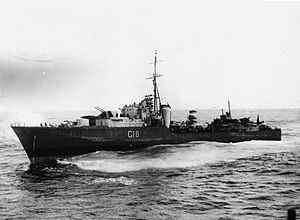HMS Zulu (F18)
 HMS Zulu
| |
| History | |
|---|---|
| Name | Zulu |
| Namesake | Zulu people |
| Ordered | 10 March 1936 |
| Builder | Alexander Stephen and Sons, Linthouse |
| Cost | £351,135 |
| Laid down | 27 August 1936 |
| Launched | 23 September 1937 |
| Completed | 6 September 1938 |
| Identification | Pennant number: L18, later F18 |
| Fate | Sunk by Italian aircraft off Tobruk, 14 September 1942 |
| General characteristics (as built) | |
| Class and type | Template:Sclass2- |
| Displacement | |
| Length | 377 ft (115 m) (o/a) |
| Beam | 36 ft 6 in (11.13 m) |
| Draught | 11 ft 3 in (3.43 m) |
| Installed power |
|
| Propulsion | 2 × shafts; 2 × geared steam turbines |
| Speed | 36 knots (67 km/h; 41 mph) |
| Range | 5,700 nmi (10,600 km; 6,600 mi) at 15 knots (28 km/h; 17 mph) |
| Complement | 190 |
| Sensors and processing systems | ASDIC |
| Armament |
|
The second HMS Zulu was a Template:Sclass2- destroyer of the Royal Navy. She was built in Glasgow by Alexander Stephen and Sons. Her keel was laid down on 10 August 1936. She was launched on 23 September 1937 and commissioned on 7 September 1938. She was sunk on 14 September 1942, off Tobruk.
Operational history
On 4 August 1942, Zulu — together with Sikh, Croome and Tetcott — sank the German submarine U-372 off Haifa. Zulu's commanding officer — Commander R.T. White, D.S.O.* — was Mentioned in Despatches for his efforts in sinking U-372.
In September 1942, Zulu participated in Operation Agreement, a commando raid at Tobruk, together with cruiser Coventry and destroyer Sikh. She had the task of scuttling Coventry after she was damaged in an air raid. Zulu was sunk by Italian Macchi C.200 Saetta fighter-bombers on 14 September 1942, after bombarding Tobruk, following the rescue of Sikh. Shore batteries hit Sikh which began to sink. White manoeuvred his ship to try to rescue Sikh and her crew, attaching lines to her to drag her out of danger, having laid a smokescreen. Sikh eventually sank but Zulu succeeded in saving the lives of a number of her crew. Aircraft continued to attack Zulu and she finally succumbed, sinking the following day. Zulu took forty casualties from these attacks: twelve killed, twenty-seven missing, and one member of the crew was wounded.
Notes
References
- Brice, Martin H. (1971). The Tribals. London: Ian Allan. ISBN 0-7110-0245-2.
- English, John (2001). Afridi to Nizam: British Fleet Destroyers 1937–43. Gravesend, Kent: World Ship Society. ISBN 0-905617-64-9.
- Friedman, Norman (2006). British Destroyers and Frigates, the Second World War and After. Annapolis, Maryland: Naval Institute Press. ISBN 1-86176-137-6.
- Haarr, Geirr H. (2010). The Battle for Norway: April–June 1940. Annapolis, Maryland: Naval Institute Press. ISBN 978-1-59114-051-1.
- Haarr, Geirr H. (2009). The German Invasion of Norway, April 1940. Annapolis, Maryland: Naval Institute Press. ISBN 978-1-59114-310-9.
- Hodges, Peter (1971). Tribal Class Destroyers. London: Almark. ISBN 0-85524-047-4.
- Lenton, H. T. (1998). British & Empire Warships of the Second World War. Annapolis, Maryland: Naval Institute Press. ISBN 1-55750-048-7.
- Rohwer, Jürgen (2005). Chronology of the War at Sea 1939–1945: The Naval History of World War Two (Third Revised ed.). Annapolis, Maryland: Naval Institute Press. ISBN 1-59114-119-2.
- Whitley, M. J. (1988). Destroyers of World War Two. Annapolis, Maryland: Naval Institute Press. ISBN 0-87021-326-1.
External links
- Uboat.net
- HMS Cavalier.org
- www.Unit histories.com White, Richard Taylor
